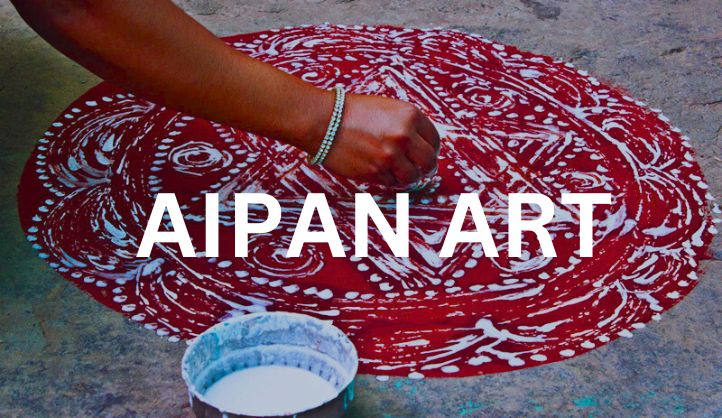Aipan art, also known as Alpana, is a traditional folk art form that originates from the Kumaon region of Uttarakhand. Rich in cultural heritage and aesthetic beauty, Aipan art is deeply embedded in the daily lives and rituals of the people of Uttarakhand. This unique art form serves as a decorative practice and holds significant cultural and spiritual meaning.
The Origins and History of Aipan Art
It has its roots in the ancient traditions of the Kumaon region. It is believed to have been practiced for centuries, passed down through generations primarily by women. “Aipan” is derived from the Hindi word “Arpan,” which means offering. Traditionally, Aipan patterns are drawn on the floors and walls of homes, especially during festivals, religious ceremonies, and auspicious occasions. These intricate designs are created to welcome deities, bring prosperity, and ward off evil spirits.
Materials and Techniques
The materials used in Aipan art are simple and natural. The primary colors used are red and white. Red is derived from a mixture of Geru (red clay) and water, which is applied as a base on the floor or wall. White is created using a paste made from rice flour and water. These eco-friendly materials reflect the harmonious relationship between the art form and nature.
The technique involves using the tips of fingers to draw intricate patterns and motifs. These patterns often include geometric shapes, floral designs, and depictions of deities and symbols from Hindu mythology. The symmetry and precision of the designs showcase the skill and creativity of the artists.
Symbolism and Significance
It is more than just decorative; it is deeply symbolic and holds cultural significance. Each design and motif has its meaning and purpose. Common motifs include-
Swastika – Symbolizes good fortune and well-being.
Footprints (Pugmarks) – Represent the footsteps of deities entering the home.
Lotus – Symbolizes purity and divinity.
Peepal Leaf – Represents the Tree of Life and is considered sacred in Hindu culture.
These motifs are often combined to create complex and meaningful patterns that enhance the spiritual atmosphere of a space.
Aipan in Festivals and Rituals
It plays a vital role in celebrating festivals and rituals in Uttarakhand. During Diwali, homes are adorned with Aipan designs to invite Lakshmi, the goddess of wealth and prosperity. For weddings, intricate Aipan patterns are drawn to bless the couple with a happy and prosperous married life. The art form is also prominent during Navratri, Makar Sankranti, and other cultural festivals, reflecting its integral role in the spiritual and cultural practices of the region.
The Revival and Modern Adaptations
There has been a renewed interest in Aipan art in recent years, thanks to efforts by cultural organizations, artists, and the government. Workshops and exhibitions are being organized to teach the younger generation about this traditional art form and encourage its practice. Additionally, Aipan designs are finding their way into modern contexts, such as home décor, clothing, accessories, and even digital media.
Many artists are experimenting with new mediums and techniques, blending traditional patterns with contemporary styles. This fusion of old and new is helping to preserve Aipan art while also making it relevant to today’s world.
How to Create Aipan Art – A Step-by-Step Guide
Creating Aipan art is both a meditative and enjoyable process. If you’re inspired to try your hand at this beautiful art form, here’s a simple guide to get you started:
1. Prepare Your Surface
Traditionally, Aipan is done on floors and walls, but you can start with a piece of cardboard or paper. Clean your chosen surface to ensure it’s free of dust and grease.
2. Apply the Base
Mix Geru (red clay) with water to form a thick paste. Apply this mixture evenly on your surface using a brush or your hands. Let it dry completely.
3. Create the Rice Paste
Mix rice flour with water to create a smooth, runny paste. This will be your drawing medium. Pour the paste into a small bowl.
4. Draw Your Design
Dip your fingers into the rice paste and start drawing your design on the dried Geru base. Begin with simple geometric shapes like dots, lines, and circles. As you become more comfortable, you can try more intricate patterns such as flowers, leaves, and deities.
5. Add Details
Once your basic design is complete, add finer details to enhance the overall look. Pay attention to symmetry and precision, as these are key elements of Aipan art.
6. Let It Dry
Allow your completed design to dry thoroughly. If you wish, you can preserve your Aipan art by applying a clear sealant over it.
Learning Aipan Art
If you are keen to learn more about Aipan art, consider attending workshops or classes offered by local artists and cultural organizations. These sessions provide hands-on experience and valuable insights into the techniques and history of Aipan art. Additionally, online tutorials and courses are available for those who prefer learning at their own pace.
Supporting Aipan Artisans
Supporting local artisans who specialize in Aipan art is crucial for preserving this cultural heritage. When visiting Uttarakhand, consider purchasing Aipan art pieces, such as wall hangings, coasters, and decorative items, directly from local markets and artists. This not only helps sustain the traditional art form but also provides economic support to the artisans and their families.
Aipan Art in Modern Design
The influence of Aipan art is increasingly visible in contemporary design. Designers and brands are incorporating traditional Aipan motifs into fashion, home décor, and even digital art. Here are some ways you can integrate Aipan art into your modern lifestyle:
Home Decor
Use Aipan-inspired cushions, rugs, and wall art to add a touch of Uttarakhand’s heritage to your home. Aipan designs can also be painted on furniture and ceramics for a unique and personalized look.
Fashion
Look for clothing and accessories that feature Aipan patterns. From sarees and scarves to bags and jewelry, Aipan art adds a distinct and elegant flair.
Digital Media
Aipan designs can be used in graphic design projects, including website backgrounds, social media graphics, and digital invitations. The intricate patterns and vibrant colors make Aipan art an eye-catching choice for digital creations.
Conclusion
Aipan art is a timeless expression of Uttarakhand’s rich cultural heritage. Its intricate designs, deep-rooted symbolism, and spiritual significance continue to captivate and inspire people around the world. By learning about and supporting Aipan art, we can help preserve this beautiful tradition for future generations. Whether through creating your own Aipan designs, attending workshops, or incorporating Aipan motifs into your modern lifestyle, there are many ways to celebrate and honor this exquisite art form.
Embrace the beauty and tradition of Aipan art, and let it bring a touch of Uttarakhand’s magic into your life.
FAQs about Aipan Craft
1. What is the Aipan craft?
Aipan is a traditional folk art from the Kumaon region of Uttarakhand, characterized by intricate patterns and motifs drawn with a white rice paste on a red clay base. It is commonly used to decorate floors and walls during festivals, religious ceremonies, and special occasions.
2. What materials are used in Aipan art?
The primary materials used in Aipan art are red clay (Geru) and rice flour. The red clay is mixed with water to create a base, and the rice flour is mixed with water to form a white paste used for drawing the designs.
3. What are the common motifs and patterns in Aipan art?
Common motifs in Aipan art include geometric shapes, floral patterns, deities, Swastikas (symbolizing good fortune), footprints (representing deities entering the home), and lotus flowers (symbolizing purity). Each motif has its own cultural and spiritual significance.
4. What is the significance of Aipan art?
Aipan art holds cultural and spiritual significance. It is believed to welcome deities, bring prosperity, and ward off evil spirits. The designs are often created during festivals, weddings, and religious ceremonies to enhance the spiritual atmosphere and invoke blessings.
5. How is Aipan art created?
Aipan art is created by applying a base layer of red clay mixed with water on the desired surface. Once the base is dry, intricate designs are drawn using a white paste made from rice flour and water. The designs are typically drawn with the fingers, showcasing the artist’s skill and precision.
6. Can Aipan art be done on surfaces other than floors and walls?
Yes, while traditionally done on floors and walls, Aipan art can also be applied to various surfaces such as paper, canvas, fabric, and even ceramics. This allows for greater versatility and the creation of Aipan-inspired decorative items and artworks.





